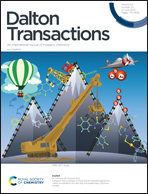UV-excited single-component white phosphor of Lu2WO6 with broad-band emission for pc-WLED†
Abstract
Obtaining white light from a single-component phosphor is still a significant challenge due to the complex energy transfer between multiple luminescent centers. Herein, white light emission is obtained in a single-component lutetium tungstate without any doping elements. By tuning the pH values during the hydrothermal synthesis, the orthorhombic Lu2W3O12 transformed into monocline Lu6WO12 and rhombohedra Lu6WO12. Only the monoclinic Lu2WO6 phase emitted light, whereas the other two phases did not. The main reason was that the exciton binding energy of Lu2WO6 was larger than that of Lu2W3O12 and Lu6WO12. Except for the 480 nm intrinsic emission of Lu2WO6, new long-wavelength excitation and emission bands were observed with the center at 340 nm and 520 nm. Based on the first-principle calculation, this new photoluminescence band comes from the electron transition between the local states of oxygen vacancies and valence band. Owing to this new broad-band emission, the white light LED lamp is fabricated by combining Lu2WO6 phosphor synthesized at pH values of 4.5 and 6 and 365 nm LED chips. The CIE coordinates of the pc-WLEDs are (0.346, 0.359) and (0.380, 0.380), respectively, and both are located in the white light region. Our research demonstrated a facile way to obtain a single-component white light emission phosphor without any doping components for pc-WLED applications.



 Please wait while we load your content...
Please wait while we load your content...